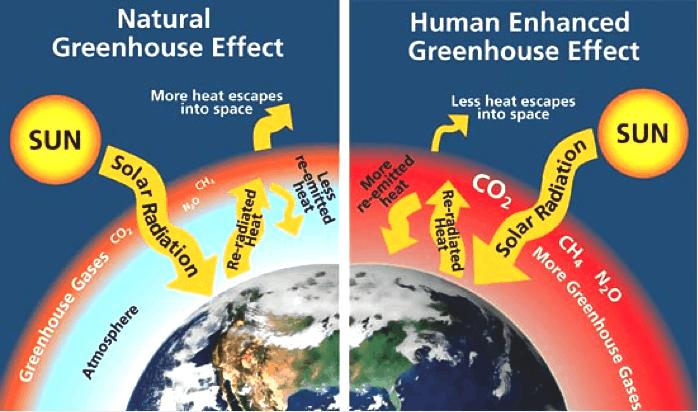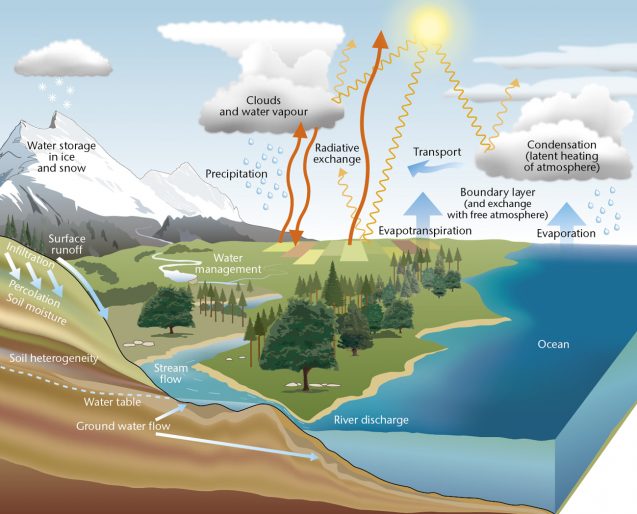- Climate is associated with sun, oceans, wind, rain, snow, forests, deserts, savannas, and human activity.
- Increase in temperature of the earth’s atmosphere because an increased amount of the heat striking the earth from the sun that is being trapped in the earth’s atmosphere and cannot be radiated out into space is called global warming.
- Climate change cause droughts and floods and affect water usage around the world. Global warming is one of the main reasons that is contributing to this problem. Because of the rise in temperature freshwater glaciers in some parts of the earth begin to melt resulting in rising sea levels.
- The temperature change alters wind pattern that brings monsoons causing drought, also unpredictable weather, water availability, exacerbating water scarcity.
- Global warming, the amount of heat produced in the earth’s atmosphere cause evaporation of water in larger amounts, this would lead to heavy rainfall in upcoming years because of the higher levels of atmospheric water vapor. The influence of Climate change on precipitation fall has a great impact on water cycle. Drastically affects the quantity and quality of water that future generations need to sustain life on this planet.
Climate change impacts
Sea level rise
Human activity is the main factor that causes global warming. Due to pollution caused by industries the emission of carbon dioxide and greenhouse gas has raised the global temperature, as a result glaciers meltdown rapidly causing rise in sea level. This in turn elevates storm, increases coastal erosion and brings hurricanes and typhoons in the ocean.
Droughts and heat wavesApart from downpours, droughts and a prolonged period of abnormally hot weather will become common. Yet, hot, dry places will get hotter and drier, and areas that once had regular rainfall will become much hotter and arid.
Changing ecosystemsTemperature change, that is rise in temperature level have effects on some staple crops. Farmers in temperate zones are finding dry conditions which are difficult for crops such as corn and wheat, and once prime growing zones are now threatened. Migration takes place among animals and fish species due to the temperature change in their own environment. The fish species migrates longer distance in the water.
Reduced food securityGlobal agriculture gets affected from global warming. Productivity changes significantly due to temperature change, different crops are grown at specific temperature and when those temperatures change, it would bring changes in productivity.
Heavy rainfall and stormsHeavy rainfall occurs due to higher level of atmospheric water vapor, water evaporates in larger amounts, and this would lead to heavy downpours. Torrential rain leading to flooding will become more common. Hurricanes and typhoons will be intense.
Melting IceIn addition to industrial revolution, carbon dioxide and other greenhouse gas emission human activities are the root cause for melting of glaciers. The rise in global temperature leads to increase of temperature even at poles resulting in rapid melting, calving into the sea and retreating to land with the rise of sea levels.

Climate change and water
- Extreme weather conditions and the change in the pattern of water cycle makeit more difficult to access safe drinking water.Nearly 450 million children do not have enough water to meet their day to day needs.
- Climate change aggravate water stress in areas where water sources are limited, leading to a conflict.
- Evaporation: Warm air holds more moisture than cool air as a result the air will suck up more water from oceans, lakes, soil and plants. This condition negatively affects agriculture and drinking water.
- Whenever there is heavy rainfall, flood, and cyclonecontaminatesentire water supply. Increases the vulnerability to children of diseases like cholera and typhoid.
- Contaminated water poses a huge threat. Temperature rise could lead to multiplication of deadly pathogens in freshwater, making the water dangerous for people to drink.
- Precipitation: Water that falls from the clouds towards the ground, especially as rain or snow. This happens when warm air cools down.Change in temperature brings a change in precipitation which causes heavy rain and snowstorms.
- The changes that happen in precipitation affect farmers and natural ecosystem. Heavy precipitation leads to floods or surface runoff and stream flow. It is a threat to human life, agriculture and economy. The runoff causes soil erosion, loss of nutrients in the soil.
- Runoff deposit sediments and contaminants in water bodies that cause harm to aquatic life and worsen conditions for people to use lakes and streams for activities such as fishing, swimming and other activities.
- Temperature in the ocean drives atmospheric patterns and alters ocean currents. Thus rainfall prediction on upcoming years varies.
Water cycle

Water demand
- Demand of water going beyond the available amount of water at a certain period called water stress. Climate change will lead to water shortage.
- Climate change modifies the volume of water required to satisfy everyday needs of human. Rise in temperature and the rate of evaporation increases the demand for water in some places.
- Destruction of vegetation worsenssoil erosion and lowers groundwater table and increase the demand for water and food.
-
The need of energy for pumping, treatment, transportation is been increased as the demand for water increases and contributes to depletion of peat lands, the carbon sinks.
What can be done?
-
Every human could contribute to reduce the impact of climate change by taking some measures such as gardening in house, like fruits and vegetables or buying locally grown vegetables and fruits, thereby to reduce the transportation. Vehicles contribute more for the emission of carbon dioxide to the atmosphere.
-
On a larger scale, if industries that use fossil fuels switch to renewable energy to a cleaner energy sources would become a major part for the betterment of our planet.
-
Waste conversion that is conversion of waste to energy source such as nutrients and biogas or biofuels.
-
Rainwater harvesting is useful in regions with uneven rainfall distribution to build the capacity to recover quickly from the damage and ensure supplies for dry periods. There are several methods which include rooftop capture for small-scale use and surface dams to slow run-off to reduce soil erosion and increase groundwater recharge or aquifer recharge.
-
In day to day activities each one of us could also contribute in conserving water, by taking shorter showers, fixing leaky plumbing, watering the lawn less often.
-
We can take a walk or ride a bike instead of driving a car. Carpooling contributes a lot to reduction of emission from vehicles
-
Improving carbon storage. Wetlands and coastal mangroves are the natural barriers of flooding, erosion and weather conditions which is effective and less expensive. Mangrove soils can conceal three or four times more carbon than terrestrial soils. The dense vegetation of the mangrove helps regulate water flow and binds the soil in flood plains, river banks and coastal lines. Protecting and expanding these types of natural buffers plays a major impact on climate change.
-
Groundwater recharge, water storage and efficient irrigation systems, and improvising agriculture and preventing water stress. Wind and solar power projects can help, too, because they use less water than traditional power plants.
-
In agricultural practices using smart conservation techniques to reduce post-harvest losses and food waste, improve organic matter to increase moisture retention in the soil, drip irrigation.
-
Water recycling or water reclamation of water from a variety of sources. Treated waste water or from other sources can be used for irrigation, industrial and municipal purposes, groundwater replenishment and environmental restoration

